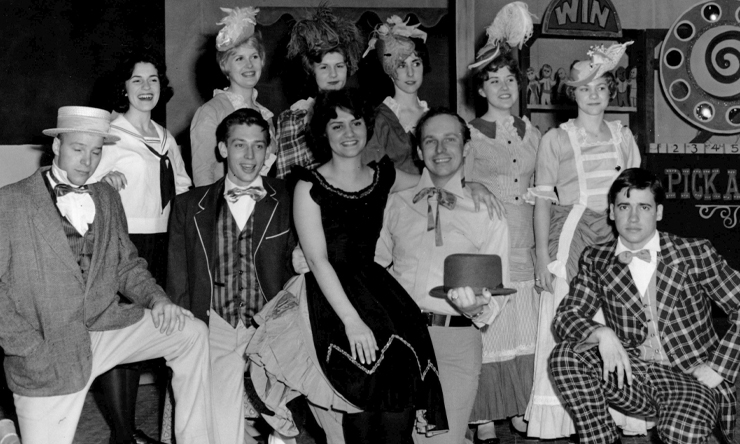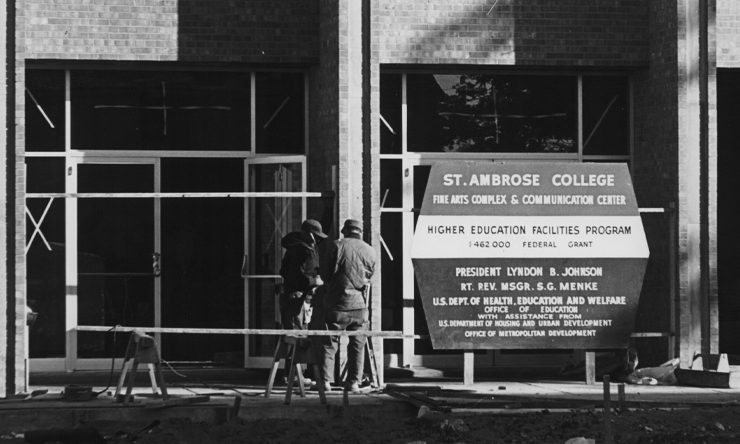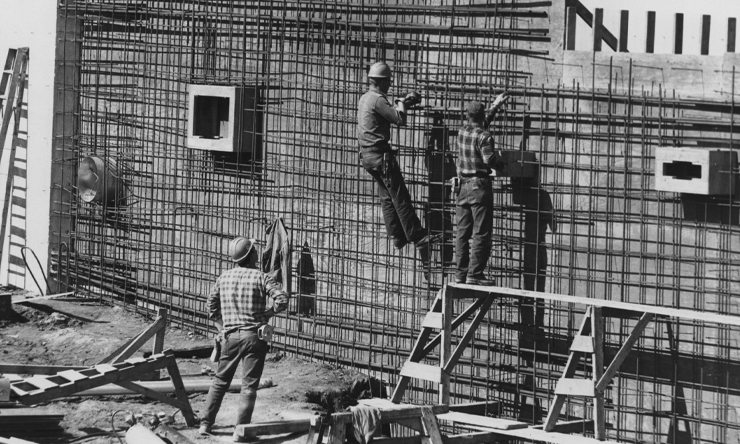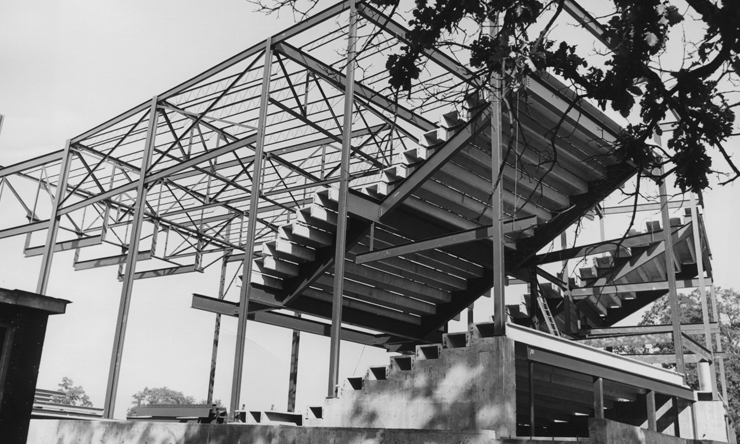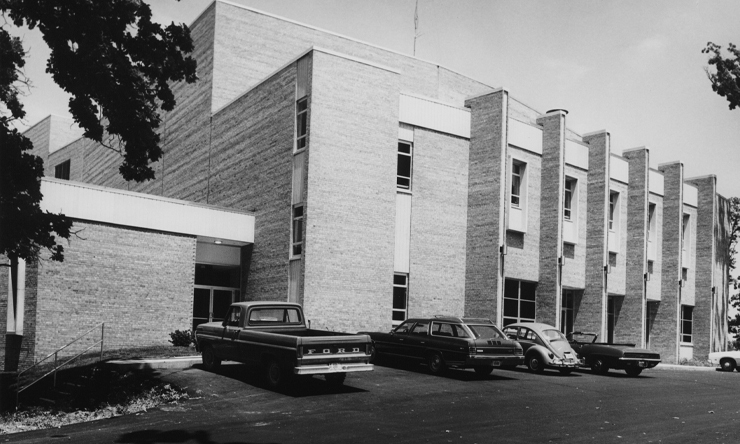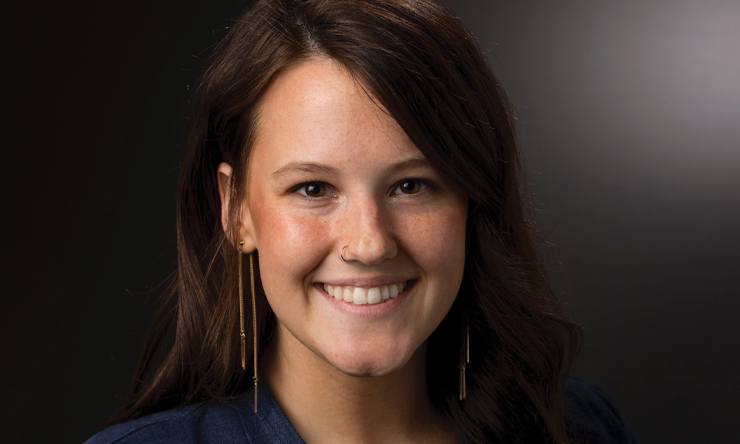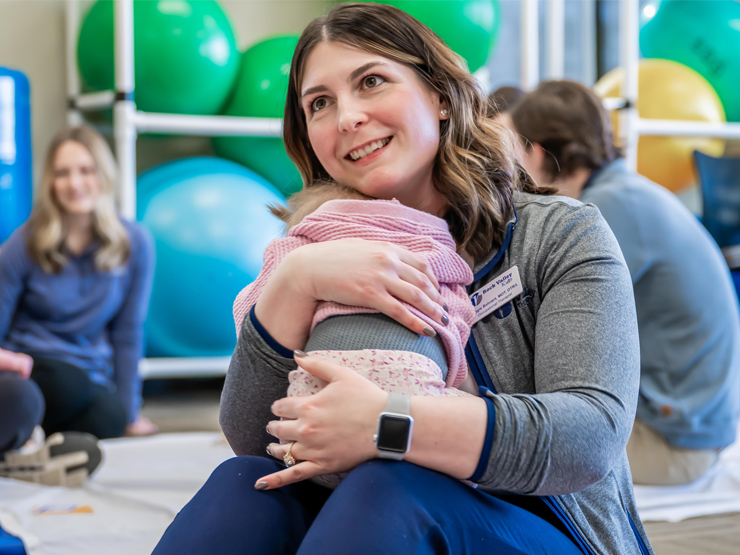As The Galvin Fine Arts Center Turns 50, History Reverberates Through Its Halls and Wall
"The story of Galvin is the story of a life, and a building does have a life."
–Mike Kennedy '60, Professor Emeritus, Mass Communications and Theatre
By Susan Flansburg
The Galvin Fine Arts Center frames the west edge of the SAU campus. Built 50 years ago to house the arts, the building's sprawling 1960s-era style contrasts dramatically with some of its more stately red brick neighbors. That's appropriate. After all, you wouldn't want to create a home for the arts that conformed to the past.
Yet stories of the past reverberate through Galvin's very walls. Take the time two program chairs erected a concrete barrier between them that had to be opened with a jackhammer. Or the time topless women danced on the stage. Or the time a professor raced into a fire to rescue the artwork of a professor from another department.
Urban myths? Some stories may be. But stories like these - along with memories of the many concerts, plays, art exhibits and broadcasts that have taken place, and most importantly, the graduates whose successful lives and careers were shaped and influenced in its classrooms, studios and stages - spill into the interviews of dozens who have called Galvin home.
In the Beginning...
Each of the arts that would ultimately find a home at Galvin had been desperate for space. Music classes were held in old Army barracks parked along the northwest corner of campus. Theatre productions were performed atop a temporary stage covering the first five rows of seats in Lewis Hall's Room 111 (dubbed Theatre 3). Art classes convened in Lewis as well, with silk screening taught in a room without ventilation. And Mass Communications - including TV and Radio - did not yet exist.
The prospect of dedicated space had the Arts faculty salivating, including the priests who chaired their departments - Rev. Msgr. Cletus Madsen '28, Music and Drama (because theatre meant "musicals" at the time); Rev. Charles Shepler '40, Speech (eventually Mass Communications); and Rev. Edward Catich '34, Art. All promoted their positions vigorously. Their programs needed space, and a lot of it.
"Galvin gave each art a home," said Kennedy, the former professor of Mass Communications and Theatre who began teaching in 1969, retired 40 years later and taught in an adjunct capacity through 2014. "But, as in any multi-use building, all departments fight for more space."
Maneuvering began before the first brick was laid, as the faculty pressed their cases. Each of the three priests was rumored to have drawn up his own blueprint, filled with ample classroom, studio and performance space for his own discipline. In the end, though, each was left wanting more.
Unscripted Galvin Drama
The cornerstone set for the new arts and communications center read 1969. That was to be Galvin's founding year. But strikes and labor disputes slowed construction significantly, delaying formal opening of the new space until spring 1971. It was during one of those disputes that a booby trap is rumored to have been set.
"Galvin is full of mysteries," KALA Operations Manager Dave Baker '88 said. "One is, Why did the roof leak all the
time? It turned out that the roof drain had cement in it. Was it delayed sabotage? A disgruntled worker? When it was cleaned out, the roof quit leaking."
Another mystery - the stuff of legend and fable now - is why was a wall erected between the Arts and Mass Communications departments, leaving just one egress apiece, and who erected it?
We may never know, but Les Bell '72 MFA, retired art professor, remembers the outcome. "I don't know who mandated a door there, maybe OSHA. I was teaching a printmaking class when the jackhammer started."
While Fr. Catich never did get the slate studio he wanted, he is most remembered for his art, and his teaching of Art. Fr. Shepler is most remembered for his advocacy for broadcasting. His newly formed Mass Communications program benefited greatly from the addition of TV and Radio, and he worked tirelessly to find the space required for its large equipment. He found one unlikely spot in Galvin's basement.
"It was just an undeveloped sand pit," SAUtv Operations Manager Duke Schneider '76 said of the space. "Fr. Shepler saw it differently. He got it emptied and put in what he called a ‘color TV studio.'"
Now settled into their new home, the arts - rubbing shoulders with each other daily - began to flourish.
Jewel of the Campus
The new fine arts and communications center opened in May 1971, with guest performers joining the St. Ambrose chorus and orchestra in the sound-perfect, 1,200-seat auditorium for Mozart's Grand Mass in C Minor. The auditorium had a busy theatre and music calendar throughout the 1971-72 academic year, highlighted by George Carlin at Homecoming and a 60-member cast performing the musical drama, La Perichole, with support from the college orchestra.
Fine art students could now showcase their work in a professional context as well. New glass cases provided a public viewing space in the art wing. Guest artists were happy to oblige, beginning with St. Ambrose graduate James Broderick '62 MFA, already in demand at galleries across the country.
Radio and TV had begun to attract attention as well, landing students like Schneider and Mass Communications Professor Ken Colwell '73, PhD, both of whom went on to make their careers at SAU. Schneider said the building itself helped make his decision to attend St. Ambrose.
"I thought, ‘Galvin is the jewel of the campus. It's so active with the things I love: Theatre, radio, the newspaper, a dark room. I want to be a part of this,'" he remembered.
The Big Fire and Other Calamities
Baker was deejaying on KALA Radio when the smoke alarm went off in October 1986. He ignored it at first, thinking it was just another fire drill. When the alarm continued to sound, however, he changed his mind. As he ran down the stairs to the first floor, Schneider was headed upstairs from the basement. "I went back downstairs for a camera when I smelled smoke," Schneider said. By the time the two of them arrived near the action, flames were shooting out the art windows.
"Mike Kennedy was running into the smoke to rescue Catich's artwork," Baker said. "People were helping him put it into the trunks of cars. It was heroic, trying to save our St. Ambrose heritage."
More than 20 years later, a storm ripped the roof off.
"Half the roof was scattered in the football practice field, water was spilling over the west balcony," Galvin Director Lance Sadlek said of the 2010 summer storm. "Antenna posts were poking through the ceiling in Allaert, windows were broken, a big puddle was in front of the stage. I don't know how we didn't miss any performances. It was a miracle."
It wasn't Sadlek's only startling moment.
"One of the first performances that happened under my tenure involved dancers who notified me that they would be dancing in briefs," Sadlek said. "I didn't have a problem with that. They didn't mention that they would be topless, and that some of the dancers were women. It was on the Holocaust and it was a beautiful piece. But when the curtain rose I thought, I'd better start looking for a new job. The Monday after, a priest wrote to me and told me it was the most beautiful performance he'd ever seen on our stage."
It's the Arts, After All
When creative people come together, magic happens. New ideas erupt. It's not about thinking outside the box. There is no box.
Mass Communications Professor Alan Sivell said it's like Harry Potter going to Hogwarts.
"Once you go through the doors, magic happens," Sivell said. "Students are safe to unleash their creativity on stage or in practice rooms or art studios. They have all this fancy modern TV equipment to use before they head off to Kansas City or Chicago or New York."
And, like Kennedy said, "they make more of it together."
Creative people tend toward synergy anyway.
"People in Galvin are treasures," Bill Campbell, PhD, professor of music, said. "It's so exciting to be collaborating and working with multiple creative people. We all do more than just our little discipline."
Theatre Professor Corinne Johnson, PhD, said cooperation is the norm. "Graphic Arts students design posters for the shows. Mass Communications does videos of them. Bill Campbell has composed original music for us. We are quite interdisciplinary."
It's Team Galvin.
"Galvin is a lab for making different kinds of arts happen, and happen together," Sadlek said. "Because the different departments are so close in proximity to each other they have to see each other. It's very beneficial. It creates Team Galvin."
It's ironic. All that legendary skirmishing was really to no good end. The arts need each other to thrive. To create the kinds of plays that win awards, artwork that is hung nationwide, broadcasts that light up TVs from here to the coasts, and music that enters our very hearts.
Go, Team Galvin!
Share This Story

